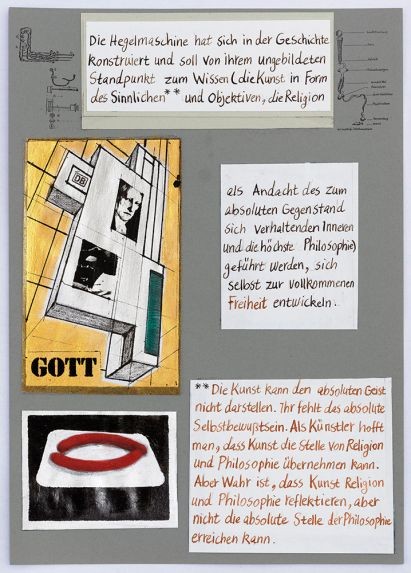Nader Ahriman
01 May - 30 Jun 2013

© Nader Ahriman
Hegelmaschine Oder Die Kunst Des Endes, 2012-2013
Courtesy Galerie Klosterfelde, Berlin
Hegelmaschine Oder Die Kunst Des Endes, 2012-2013
Courtesy Galerie Klosterfelde, Berlin
NADER AHRIMAN
Meta-Kubismus
1 May – 30 June 2013
On several occasions in the past not only the end of philosophy, but also the end of painting was proclaimed – with either regret or relief. Nader Ahriman (*1964, lives in Berlin) unites both and in doing so consciously sets himself apart. He "paints" philosophical concepts.
His drawings, collages and paintings reflect key topics such as man, machine, the relationship of both to each other and to nature, or man’s search for an intellectual home. Yet it is not easy to discover these subjects in his constellations of forms and figures. "I don’t wish my images to be decoded like posters; they have to be interpreted." Specifically, observers are confronted with complex and charged dream-like images in which the supernatural and subconscious are latent. The images refer neither to a specific place nor a specific time. Spaces remain undefined and unreal, have figures floating or crashing down, only portray vague outlines and primarily evoke the drama of theater. And it also remains open whether the scenes play out in the past or in the future, although the philosophical references to Hegel, Nietzsche or Lukács provide the historical framework. Ahriman combines their conceptual approaches and ideas with his knowledge of art-historical citations to create a strange imagery brimming with references, which has strong echoes of Giorgio de Chirico and Max Ernst, but equally of Oskar Schlemmer or Rube Goldberg.
His works are composed as series, which combine recurring motifs with one another in different variations. The series he has produced since 2002, "Etüden transzendentaler Obdachlosigkeit" (Etudes of transcendental homelessness, 2002-2005), "Stromboli – Die Gestalt des Selbstbewusstseins" (Stomboli – The embodiment of self-confidence, 2006) and "Hegelmaschine oder die Kunst des Endes" (Hegel machine or the art of the end, 2012-2013) he groups under the title of "Meta-Kubsimus" (Meta Cubism), though "Meta Cubism has nothing to do with the Cubism of Braque and Picasso, but rather with the late Cézanne, who wanted to depict the idea of things".
Meta-Kubismus
1 May – 30 June 2013
On several occasions in the past not only the end of philosophy, but also the end of painting was proclaimed – with either regret or relief. Nader Ahriman (*1964, lives in Berlin) unites both and in doing so consciously sets himself apart. He "paints" philosophical concepts.
His drawings, collages and paintings reflect key topics such as man, machine, the relationship of both to each other and to nature, or man’s search for an intellectual home. Yet it is not easy to discover these subjects in his constellations of forms and figures. "I don’t wish my images to be decoded like posters; they have to be interpreted." Specifically, observers are confronted with complex and charged dream-like images in which the supernatural and subconscious are latent. The images refer neither to a specific place nor a specific time. Spaces remain undefined and unreal, have figures floating or crashing down, only portray vague outlines and primarily evoke the drama of theater. And it also remains open whether the scenes play out in the past or in the future, although the philosophical references to Hegel, Nietzsche or Lukács provide the historical framework. Ahriman combines their conceptual approaches and ideas with his knowledge of art-historical citations to create a strange imagery brimming with references, which has strong echoes of Giorgio de Chirico and Max Ernst, but equally of Oskar Schlemmer or Rube Goldberg.
His works are composed as series, which combine recurring motifs with one another in different variations. The series he has produced since 2002, "Etüden transzendentaler Obdachlosigkeit" (Etudes of transcendental homelessness, 2002-2005), "Stromboli – Die Gestalt des Selbstbewusstseins" (Stomboli – The embodiment of self-confidence, 2006) and "Hegelmaschine oder die Kunst des Endes" (Hegel machine or the art of the end, 2012-2013) he groups under the title of "Meta-Kubsimus" (Meta Cubism), though "Meta Cubism has nothing to do with the Cubism of Braque and Picasso, but rather with the late Cézanne, who wanted to depict the idea of things".
